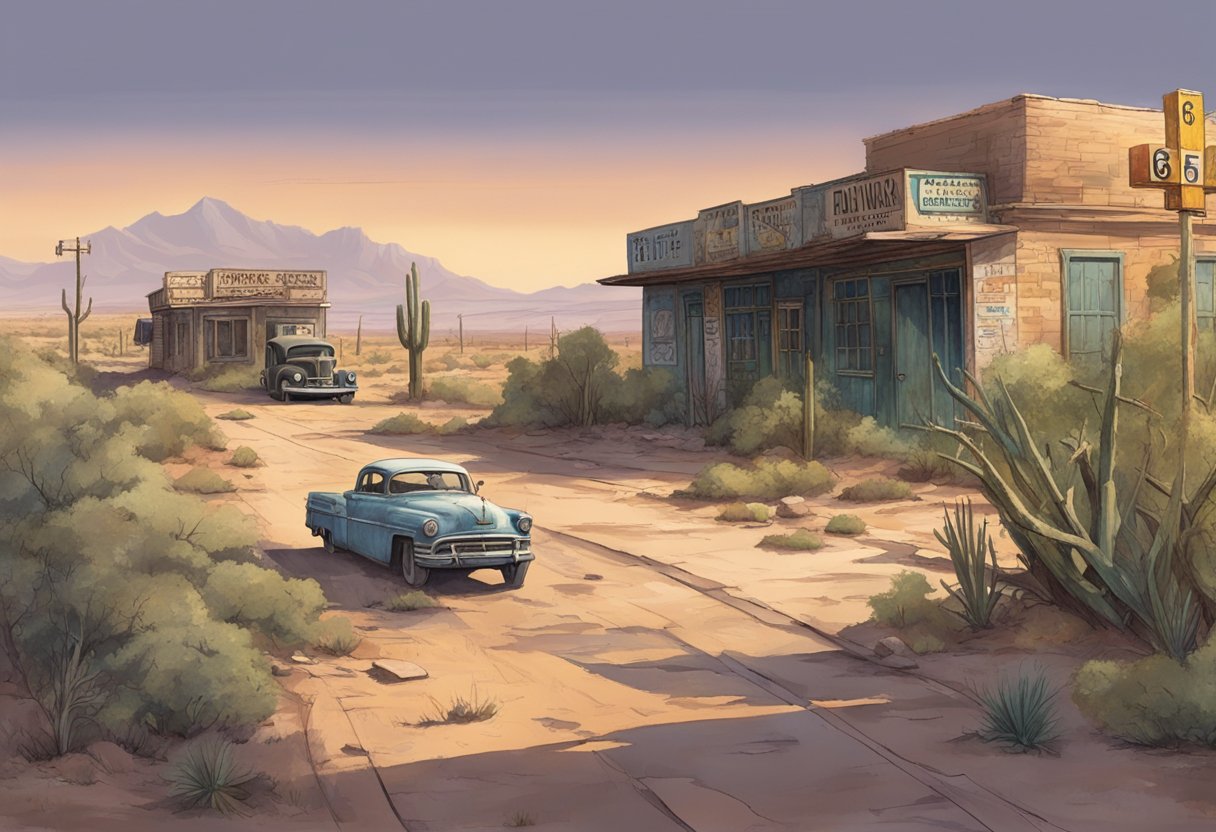Route 66, often romanticized as the “Mother Road” and “Main Street of America,” is steeped in history and nostalgia. Initially established in 1926, this historic route once offered millions the path to a promised land of opportunity, weaving through eight states from Chicago to Santa Monica. While today it embodies the spirit of the classic American road trip, the reality is that portions of Route 66 can present dangers to uninformed travelers. The road’s legacy includes stretches that have fallen into disrepair, lacking the modern safety features of newer highways.

Despite the reverie surrounding Route 66, factors such as uneven pavement, narrow lanes, and a lack of shoulder areas contribute to the risks. Some sections of the original road have not been updated to accommodate today’s traffic volumes or vehicle sizes, leading to potential hazards. Furthermore, since Route 66 is no longer part of the United States Highway System, certain segments are not as well-maintained as other roads, potentially increasing the chances for accidents.
Moreover, drivers are often distracted by the allure of Americana, leading to less attention on the road itself. While undeniably rich in cultural landmarks and scenic vistas, this can pose a further safety risk as drivers navigate the storied but sometimes treacherous path of America’s historic Route 66.plotlibrary
Historical Significance
Route 66 has been an emblematic pathway signifying America’s development and cultural identity. From the migration prompted by the Great Depression to its mark on popular culture, the road’s history reflects significant chapters in American history.
Inception and Development
Considered a pioneer for modern highways, Route 66 was established in 1926, during a burgeoning era of American highway construction. Cyrus Avery, often referred to as the Father of Route 66, spearheaded the Good Roads Movement that galvanized support for a network of reliable roads. The route burgeoned from Chicago to Santa Monica, passing through diverse landscapes and communities.
- Key Dates:
- 1926: Route 66 officially established
- 1930s: Becomes a major migration route during the Dust Bowl
Cultural Impact
The road has had profound influences on American culture, becoming a quintessential representation of American travel. It inspired John Steinbeck to christen it “The Mother Road” in his novel The Grapes of Wrath, depicting the migration during the Dust Bowl and Great Depression. Additionally, Route 66 has been celebrated in music by artists like Nat King Cole and Bobby Troup, and named the Will Rogers Highway after the beloved humorist and actor.
- Cultural Milestones:
- 1939: John Steinbeck’s The Grapes of Wrath published
- 1946: Released song “(Get Your Kicks on) Route 66”
Decline and Decommissioning
Post World War II, the traffic on Route 66 surged, exposing its inadequacies and prompting the development of the Interstate Highway System, championed by President Dwight D. Eisenhower, influenced by his appreciation for the German Autobahn. Route 66 gradually fell out of favor as newly constructed interstates offered faster and more direct routes. The highway was officially removed from the United States Highway System in 1985.
- Decline Factors:
- 1956: Interstate Highway System inaugurated
- 1985: Route 66 decommissioned
Geographical Overview

Route 66, often celebrated as the “Main Street of America,” spans across a diverse range of geographical landscapes and weather conditions, passing through major cities and small towns alike.
States and Cities
- Illinois: Starting from Chicago, the route proceeds southwest through Illinois, touching cities such as Springfield
- Missouri: In Missouri, significant locales like St. Louis and the scenic Meramec Caverns, associated with Jesse James, mark the journey
- Kansas: A short stretch through Kansas reveals the quaint charm of small towns that encapsulate the heartland’s spirit
- Oklahoma: The route continues through Oklahoma and its many inviting towns with rich histories
- Texas: Texas presents travelers with a mixture of bustling cities and quiet, windswept towns
- New Mexico: Historic cities like Santa Fe are encountered in New Mexico’s varied terrain.
- Arizona: Arizona offers dramatic landscapes, including the Painted Desert and the Grand Canyon, and nostalgic ghost towns along the way
- California: The route concludes in California, where it reaches from the desert to the coast, ending at the Santa Monica Pier near Los Angeles
Notable Attractions
- The Grand Canyon, AZ: A natural wonder positioned close to Route 66, offering breathtaking views
- Meramec Caverns, MO: These extensive caverns are part of Route 66 folklore linked to the legendary outlaw Jesse James
- Meteor Crater, AZ: Near Winslow, this well-preserved meteorite impact site attracts geology enthusiasts
- Painted Desert, AZ: A beautiful expanse of colorful badlands that dazzles visitors
- Cadillac Ranch, TX: An iconic public art installation featuring half-buried Cadillacs painted in vibrant hues
- Santa Monica Pier, CA: The historic end of the trail, the pier is a symbol of the vast journey across the American landscape
Dangers of Route 66
Historically known as “Bloody 66”, Route 66 presents various risks to its travelers, from road safety concerns to environmental hazards. It is critical for motorists to approach this iconic road with caution and awareness of the potential dangers.
Road Safety Concerns
Fatal Accidents: Route 66 has seen a significant number of fatal accidents, particularly during the boom of road travel from the 1940s through the 1970s. While safety measures have improved, the history of fatalities cannot be ignored.
Maintenance and Road Conditions: Many sections of the highway have suffered from inadequate maintenance leading to conditions that pose risks. These include:
- Narrow lanes: Some stretches feature lanes that are narrower than modern highways, requiring increased driver attention and slower speeds
- Varying road conditions: Travelers may encounter a mix of well-maintained sections and deteriorated segments with potholes or unclear markings
Environmental Hazards
Extreme Weather: Drivers on Route 66 must be prepared for:
- Extreme Heat: In desert areas, temperatures can skyrocket, heightening the risks of vehicle overheating and tire blowouts
- Water-Related Dangers: Flash floods can occur, making roadways hazardous or impassable
Weather Conditions: Route 66 traverses diverse climates, and weather conditions can change abruptly. Motorists should be vigilant and ready to adapt to:
- Sudden storms
- Extreme cold or heat
- Icy roads in northern sections during winter
Travelers are urged to remain cautious, regularly check weather forecasts, and implement appropriate safety measures before and during their journey on this historic highway.
Modern-Day Travel

U.S. Route 66, commonly referred to as the Mother Road or the Main Street of America, continues to capture the imagination of many travelers. Visitors often embark on a nostalgic journey to experience the scenic beauty and historic landmarks dotted along this iconic highway.
Tourism and Economy
Historic Route 66 has seen a resurgence of interest as a tourist destination, driving local economies across the eight states it traverses. Small businesses cater to the influx of tourists, from vintage motels to classic diners. The traffic congestion often associated with popular attractions can be a concern; however, many tourists plan their itinerary to avoid peak travel times.
Travelers often factor in road conditions and maintenance, which vary along the route, with some sections beautifully preserved and others in need of upgrades. The U.S. Highway 66 Association, among other organizations, pushes for preservation efforts to boost tourism and aid local economies.
Preservation Efforts
Preservation of Historic Route 66 is crucial in maintaining the integrity of the road for future generations of travelers. Initiatives led by various groups, including the National Scenic Byway program, aim to improve road conditions and enhance the overall travel experience.
- Maintenance: Regular upgrades and maintenance are done to ensure safe travel conditions
- Upgrades: Strategically important sectors of the route receive upgrades to accommodate modern-day traffic and prevent congestion
The overall sustainability of Route 66 depends on these preservation efforts that enhance its status as a historic and cultural landmark while ensuring it remains a viable option for contemporary explorers.
Cultural References and Legacy

Route 66 has permeated various aspects of culture, becoming a symbol in literature, music, film, and media, often representing the era’s travels and the American spirit.
Literature and Music
In the sphere of literature, John Steinbeck’s novel The Grapes of Wrath is a significant work that illustrates the desperate travels of Dust Bowl migrants along Route 66 during the Great Depression, earning it the nickname “Mother Road.” Steinbeck’s portrayal exposes the road as a pathway to hope and despair, shaping Route 66’s identity in American culture.
Music, too, has celebrated Route 66. Nat King Cole and Bobby Troup are two artists who cemented the highway’s legendary status through their performances of “(Get Your Kicks on) Route 66.” The song invites listeners to travel the storied path, engaging with the cultural and geographical tapestry that defined the era.
Film and Media
Route 66’s legacy extends into film and media where it has served as a backdrop for the narratives of travelers and tourists. It’s been featured prominently in various works, allowing actors and comedians to explore and reflect the country’s changing landscape and culture. The road’s iconic status has helped it to become a symbol of freedom, adventure, and discovery across numerous films and television shows, influencing the portrayal of American road travels.
Navigating Route 66 Today

When embarking on a journey along the historical Route 66, roadtrippers should plan their itinerary with several considerations in mind. This storied stretch from Chicago to Los Angeles presents unique challenges that demand attention.
Infrastructure and Safety: Route 66’s charm lies in its vintage character; however, the road’s dated design has implications for safety, with some sections featuring narrow lanes and limited signage. Enhancing visibility after dusk can be problematic due to poor or antiquated lighting, making nighttime navigation more demanding.
Preparation for the Trip:
- Map Your Stops: Due to the sporadic nature of service areas, having a comprehensive plan for fuel, food, and water is important, especially in remote regions.
- Weather Readiness: Be prepared for extreme weather conditions that can include intense heat, severe storms, or even snow in higher altitudes.
Travelers should remain vigilant to the dynamic conditions of the road. Regularly updated navigation aids are advisable to ensure the most recent information guides their travel.
Resources and Emergency Planning:
- Hydration: Always carry an ample supply of water.
- Weather Apps: Keeping informed about local weather forecasts can prevent being caught in undesirable conditions.
Ultimately, a journey on Route 66 can be a fulfilling adventure, but it requires modern travelers to stay informed and prepared for an array of circumstances they may encounter along this iconic yet challenging route.

